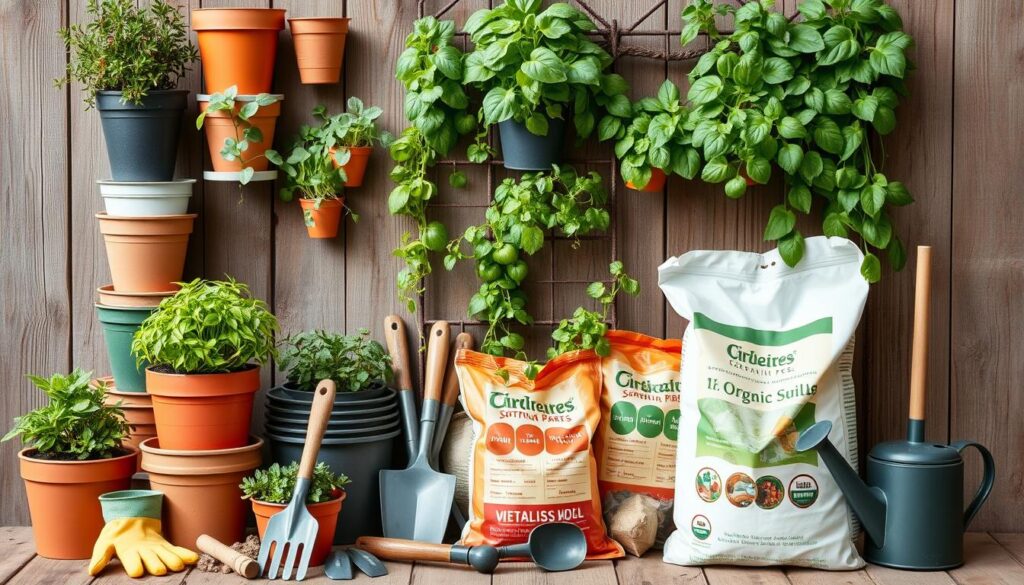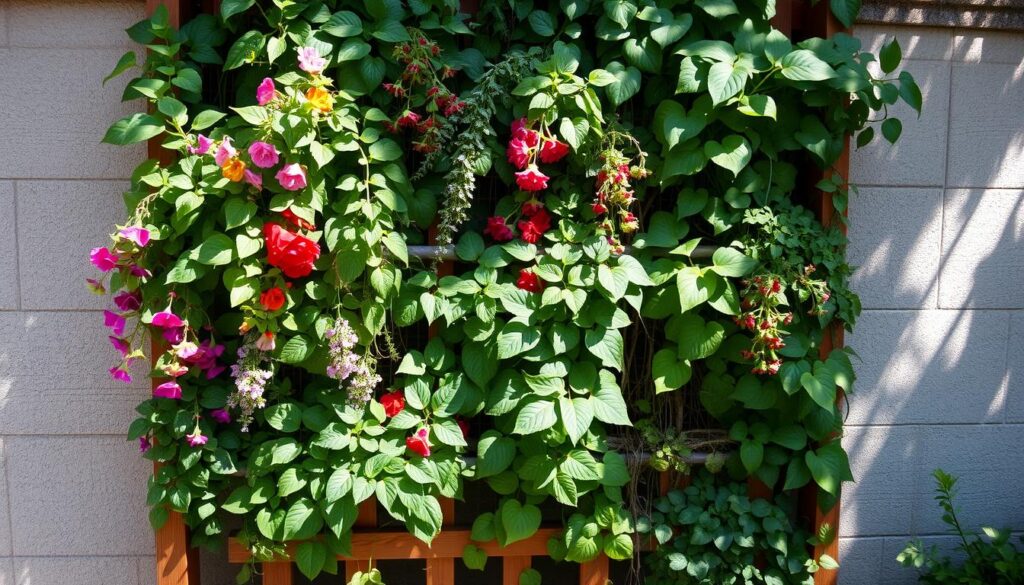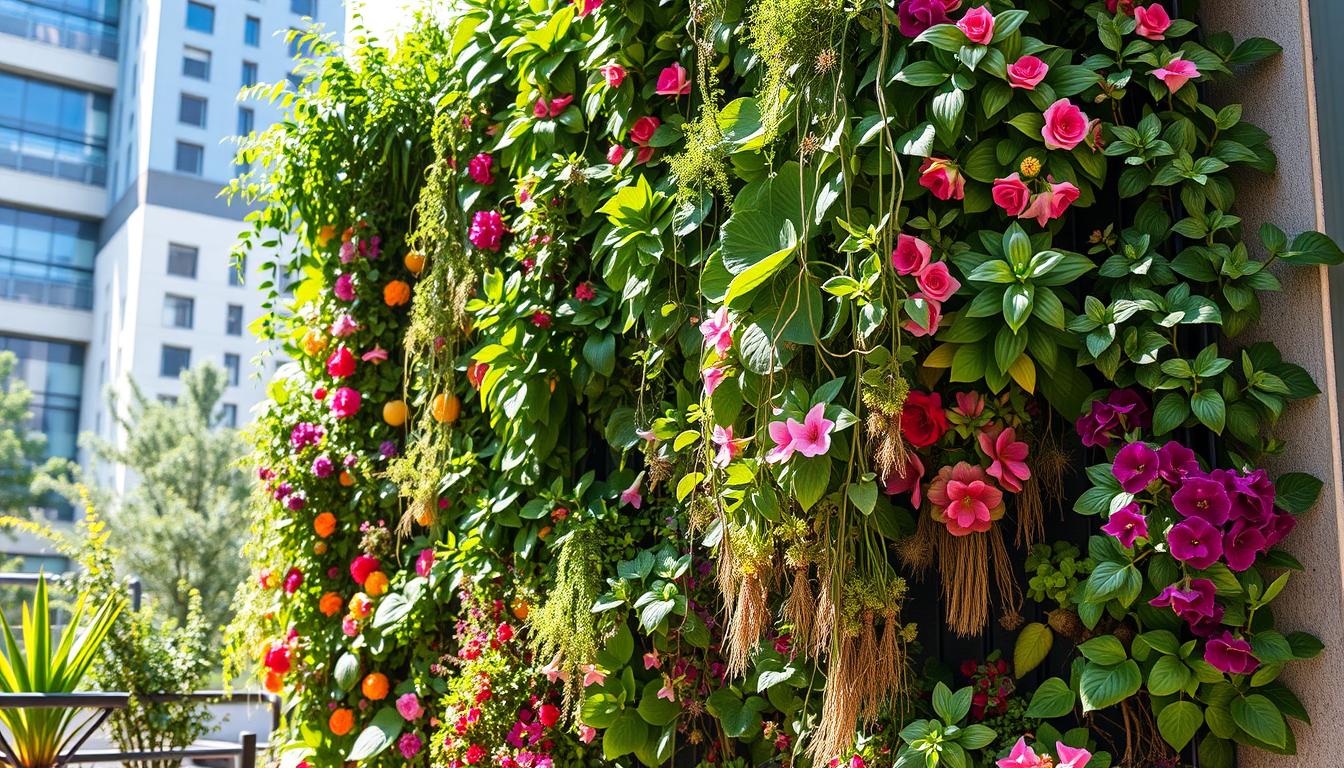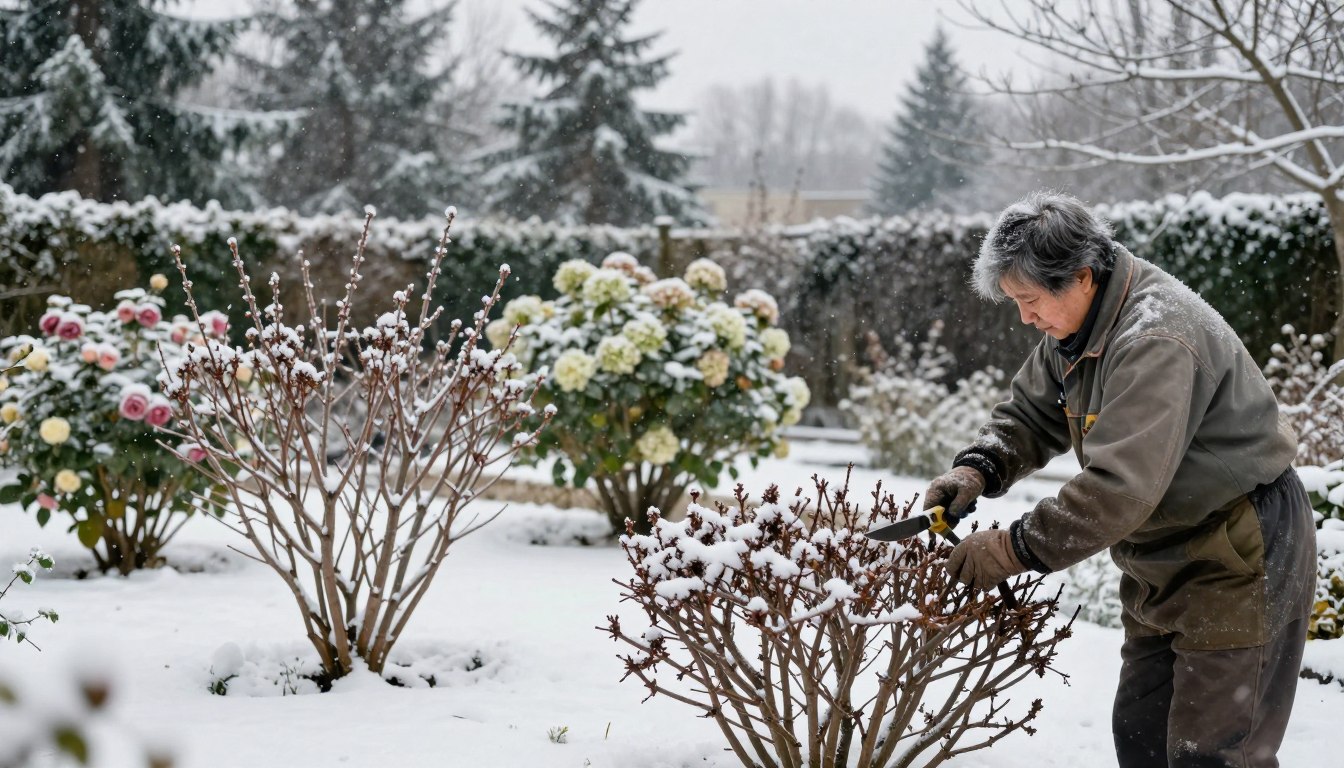Finding space for a garden in the city can be hard. But, vertical gardening is a game-changer. It lets you grow stunning living walls or space-saving gardens. This guide will show you how to grow your dream garden in small spaces.
Vertical gardening uses vertical space to grow plants, flowers, and food. It’s a smart way to use little space and looks great. It’s perfect for city folks, suburban homes, or anyone with a small space. This guide will help you grow up, not out.
Key Takeaways
- Discover the transformative potential of vertical gardening in urban and small-space environments.
- Learn about the various types of vertical garden structures and their unique advantages.
- Explore the key components for successful vertical gardening, from plant selection to maintenance.
- Understand the essential tools and materials needed to create your own thriving vertical garden.
- Gain insights into the best practices for choosing the perfect location and optimizing growing conditions.
Understanding the Basics of Vertical Gardening
Vertical gardening, also known as living walls or green walls, is a new way to garden in small spaces. It lets people grow plants up instead of out, saving space. This method is great for city folks and those with tiny yards.
Types of Vertical Garden Structures
There are many ways to set up a vertical garden. You can use trellises, pocket planters, or hanging systems. Trellises help plants climb up walls. Pocket planters show off plants that spill over. Hanging systems create a lush, three-dimensional wall.
Benefits of Growing Vertically
- Space-efficient: Vertical gardening makes the most of vertical space, letting you grow more in less area.
- Improved air quality: Living walls and green walls clean the air by taking in carbon dioxide and making oxygen.
- Increased urban food production: Vertical gardens let city folks grow their own food, cutting down on food transport’s environmental harm.
- Enhanced aesthetics: Vertical gardens bring a beautiful, natural touch to any indoor or outdoor spot.
Key Components for Success
To have a successful vertical garden, think about lighting, water, and soil. Plants need enough sunlight, natural or artificial. A good watering system, manual or automatic, keeps your garden watered and fed.
Essential Tools and Materials for Your Vertical Garden
Starting a vertical garden needs the right tools and materials. You’ll need sturdy containers and efficient irrigation systems. Let’s look at what you need for a successful vertical garden.
Containers and Growing Media
The base of your vertical garden is the containers. Choose lightweight, durable, and modular planters. They should be easy to stack or arrange to use your space well. Look into container gardening options like pocket planters or vertical garden systems.
For growing media, pick a mix that drains well and is rich in nutrients. Stay away from heavy soil. It can make your vertical garden too heavy and less flexible.
Structural Support
Your vertical garden systems need a strong support. Use trellises, wire frames, or old shelving units. Make sure they can hold the weight of your plants and containers. They should also handle wind and rain well.
Irrigation and Watering
Watering right is key for your modular planters. Get an efficient irrigation system like drip lines or self-watering devices. This way, your plants get the right moisture without wasting water.
| Essential Tools | Materials |
|---|---|
|
|
With these tools and materials, you’re ready to start a thriving container gardening setup. It will make the most of your space and help your plants grow well in a vertical garden.

Choosing the Perfect Location for Your Living Wall
When it comes to indoor gardening, picking the right spot is key. Whether you’re aiming for a sustainable horticulture display or boosting your green architecture, the location matters a lot.
Indoor vs Outdoor Considerations
Deciding between an indoor or outdoor living wall depends on several things. These include the climate, light, and your space’s design. Indoor vertical gardens offer constant greenery and a natural feel. Outdoor vertical gardens show your dedication to sustainable horticulture and blend well with the environment.
Light Requirements and Exposure
- Check the light in your chosen spot, as plants need different amounts.
- Make sure it gets enough sunlight or has good artificial light for an indoor garden.
- Think about the wall’s orientation to get the right light.
Weight-bearing Capacity Assessment
Before setting up your vertical garden, check the wall’s weight-bearing capacity. The size, materials, and design of your garden affect how much it can hold. If unsure, get a pro’s opinion on your wall’s strength.
| Indoor Gardening | Outdoor Gardening |
|---|---|
| Controlled environment | Exposed to natural elements |
| Year-round greenery | Seasonal variations |
| Requires artificial lighting | Relies on natural sunlight |
| Lighter weight considerations | Heavier weight requirements |
By thinking about these points, you can find the best spot for your indoor gardening or sustainable horticulture project. This ensures a beautiful and thriving vertical garden that improves your green architecture.

Best Plants for Vertical Gardens
Vertical gardening lets you grow many types of plants, both pretty and edible. You can have climbing vines and trailing succulents in your space. The right plants can make your vertical garden look amazing and useful. Here are some top picks for your vertical garden.
Ornamental Favorites
- English Ivy – This classic vine loves vertical gardens. It flows beautifully down walls and trellises.
- Fuchsia – Their bright, hanging flowers make fuchsias a standout in vertical gardens.
- Geraniums – Easy to care for, geraniums are great for vertical gardens and edible walls.
Edible Delights
- Strawberries – Perfect for hanging baskets, strawberries grow well in vertical spaces and give lots of fruit.
- Cherry Tomatoes – Small, climbing tomatoes are perfect for trellises. They offer tasty, easy-to-grow fruit.
- Herbs – Herbs like basil and rosemary do well in vertical gardens. They add flavor and beauty.
When planning your vertical garden, mix plants that grow well together. This makes your garden look great and work well. With the right vertical planting techniques and containerized planting, your garden can be a lush, edible wall. It will make your home and cooking better.

Advanced Growing Systems: Hydroponics and Aeroponics
Hydroponic and aeroponic systems are changing vertical gardening. They don’t need soil, which is great for city gardens and big farms. These methods help plants grow better and faster.
Understanding Hydroponic Systems
Hydroponic gardening uses water full of nutrients instead of soil. Plants get what they need through a system of pumps and pipes. This way, plants grow faster and stronger, using less water.
Aeroponic Technology Basics
Aeroponic systems go even further than hydroponics. They hang plants in the air and spray them with nutrients. This method is super efficient, giving plants exactly what they need to grow fast.
Nutrient Management Tips
- Carefully monitor and adjust nutrient levels to meet the specific requirements of your plants.
- Utilize organic or synthetic fertilizers tailored for hydroponic or aeroponic systems.
- Regularly test the pH and electrical conductivity (EC) of the nutrient solution to maintain optimal conditions.
- Consider supplementing with essential micronutrients to ensure comprehensive plant nourishment.
Using hydroponic and aeroponic systems opens up new possibilities in gardening. These methods offer great control and efficiency. They help grow amazing plants, even in small spaces.
Space-Saving Design Strategies
When it comes to small space gardening, creativity is key. Vertical gardening offers a wealth of design possibilities. You can make the most of your growing potential in limited areas. Options include cascading planters and modular growing systems.
Tiered vertical gardens are an innovative approach. They let you stack multiple levels of plants. This makes the most of your wall or balcony space. These gardens can create a stunning, living display that adds visual interest and depth.
Modular growing units are another clever strategy. These self-contained, often wall-mounted systems let you customize your vertical garden layout. You can choose a single unit or a dynamic arrangement. Modular designs offer a versatile and space-saving solution.
Cascading planters are great for those with limited floor space. These vertical planter systems cascade downward, creating a lush, tiered effect. You can hang them from ceilings, attach them to walls, or nestle them into corners. The possibilities are endless.
By exploring these innovative space-saving design strategies, you can transform even the smallest of spaces into a thriving, productive vertical garden. The key is to think vertically, stay adaptable, and let your creativity guide the way.
“The true secret of happiness lies in taking a genuine interest in all the details of daily life.” – William Morris
Maintenance and Care Guidelines
Keeping a vertical garden healthy needs a lot of care. This includes watering, pruning, and managing pests. By using the right methods, gardeners can keep their gardens looking great for a long time.
Watering Systems and Schedules
Watering right is key for a vertical garden’s success. Using systems like drip irrigation or mist helps save water and keeps plants moist. It’s important to plan a watering schedule based on the plants, weather, and where they grow.
Pruning and Plant Health
Pruning regularly keeps your garden looking neat. It helps plants grow better and prevents them from getting too crowded. Also, watching for diseases and pests is vital for a healthy garden.
Pest Management Solutions
Vertical gardens face pests like aphids and spider mites. Using natural pest control, like bugs that eat pests, is a good choice. Regular checks and quick action help keep your garden pest-free.
Following these care tips helps gardeners keep their vertical gardens or aquaponics systems thriving. This makes food production more sustainable and efficient.
Sustainable Practices in Vertical Growing
Vertical gardening is becoming more popular, and it’s key to use sustainable methods. These methods help us reduce our impact on the environment. We can grow our green walls and tower gardens in ways that are good for the planet.
Water management is a big part of sustainable vertical agriculture. Using efficient irrigation systems like drip or micro-sprinklers cuts down water use. Also, hydroponic or aeroponic setups help save water.
Organic pest control is vital for green gardening. Instead of chemicals, we can use natural methods. This includes introducing beneficial insects and using plant-based repellents. Keeping a diverse ecosystem in our green walls and tower gardens helps too.
Energy efficiency is another key area. Using renewable energy like solar panels or wind turbines makes vertical gardens greener. Also, improving lighting and climate control systems saves even more energy.
| Sustainable Practice | Benefits |
|---|---|
| Water-efficient Irrigation | Reduces water consumption and waste |
| Organic Pest Management | Eliminates the need for harsh chemicals, promoting a healthier ecosystem |
| Renewable Energy Integration | Lowers the carbon footprint and energy costs of vertical gardens |
By using these sustainable practices, we can grow our own food and plants. We also help make cities more sustainable and diverse. As we grow vertical agriculture, we must do it in a way that’s good for the environment. This will help create a greener future for all.
Conclusion
Urban gardening through vertical farming is a smart way to grow plants in small spaces. It turns city areas into green spots, bringing fresh food and beauty to both indoors and outdoors.
Want to make a living wall, a hydroponic system, or a simple vertical garden? The options are endless. With the right tools and knowledge, you can make your urban garden thrive. This helps make our world greener.
Ready to start your own indoor garden or compact farming project? It’s easy with some planning and effort. Your vertical garden will be a lush spot that gives you fresh food and makes your space look better. Let’s grow a greener future together.
FAQ
What is vertical gardening, and how does it differ from traditional gardening?
Vertical gardening grows plants up instead of out. It uses space on walls to grow more plants in small areas. This is different from traditional gardening, which grows plants in beds on the ground.
What are the primary benefits of vertical gardening?
Vertical gardening saves space and improves air quality. It also uses less water and lets you grow many plants in small places. Plus, it makes spaces look better and supports eco-friendly living.
What types of vertical garden structures can I use?
You can use trellises, living walls, pocket planters, hanging baskets, and modular systems. The right choice depends on your space, plants, and what you like.
What are the essential tools and materials needed to start a vertical garden?
You’ll need containers, growing media, irrigation, support, and plants. The exact needs vary based on your garden type.
How do I choose the perfect location for my vertical garden?
Look at the light, wall strength, and if it’s indoors or outdoors. Choosing well ensures your garden thrives.
What are some of the best plants for vertical gardening?
Good plants include vines, herbs, leafy greens, and small veggies. Pick plants that fit your garden’s light, water, and space needs.
What are hydroponic and aeroponic systems, and how can they be integrated into vertical gardening?
Hydroponic and aeroponic systems use water instead of soil. They’re great for vertical gardens, offering precise control and space efficiency.
How do I maintain and care for my vertical garden?
Regular watering, pruning, pest control, and health checks are key. Care needs vary by plants and system. A consistent routine is vital for success.
How can I incorporate sustainable practices into my vertical gardening efforts?
Use water-saving methods, organic pest control, and eco-friendly materials. These practices help the environment and your garden’s health.






